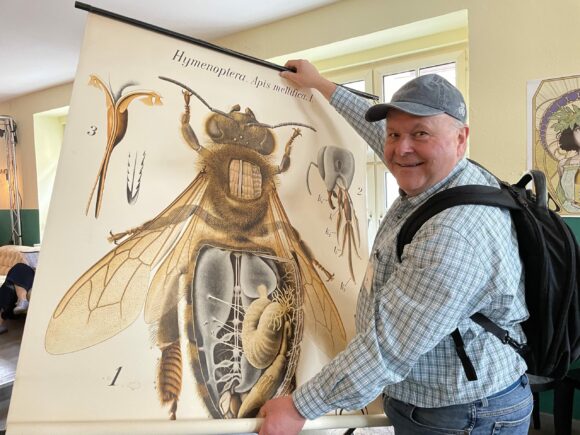In the summer of 2021, water ran into the basement of the A building after heavy rain. But what had happened? Where did all the water come from? And what role did the ponds on the university campus play? In the aftermath, some things become clearer.

They invite you to relax and are the habitat for many different plants and animals. In addition to fish, ducks and frogs, deer have also been observed there. But the two ponds actually serve a different purpose: they are retention basins that are part of the university’s sophisticated rainwater retention system. The purpose of the entire stormwater retention system is to prevent the sewer system from being overloaded by large amounts of water, such as during a heavy rain event, and thus also to prevent flooding.
Excess water flows into retention basins
The first instance of this system is the green roofs of the university buildings. They have a substrate layer that can absorb and store water. On the one hand, the stored water supplies the plants on the roofs, and on the other hand, it creates a cooling effect so that the buildings do not heat up as much in summer as a result. If the roofs cannot hold any more water, the excess water flows into the retention basins and, if it cannot be retained there any longer, then further into the sewage system. The higher retention pond between buildings A and B, is connected by an overflow to the lower pond next to the cafeteria.
Another element of the stormwater retention system is infiltration areas where stormwater can be quickly absorbed into the ground, preventing it from flowing over the surface directly into the sewer. The parking lots for employees and students of the university are designed as such.
Why did the water run into the basements of the A Building?
In the summer of 2021, several events came together that negatively compounded and led to the flooding of the basement spaces. First, it was a very rainy summer and the soils were saturated and could barely absorb water. Then there was a heavy rain event with large amounts of water in a very short time. The water masses were led from the roofs directly into the retention basins. The basin between building A and B was filled in a very short time. Due to the overflow, not enough water could drain into the pond and as a result the basin overflowed. The water subsequently poured into the basement rooms of Building A, paralyzing parts of the IT infrastructure and causing further damage to the building and equipment.
Prevention measures implemented
To prevent a recurrence of these events, extensive construction measures took place in the summer of 2022. In the process, the overflow of the retention basin between Buildings A and B was extended. This was a response to the changing weather conditions caused by climate change. The water management experts based their calculations of such retention systems on statistical weather data from the German Weather Service from the years 1951-2010. However, rainfall events have changed massively in some cases over the past 10 years, but this is not taken into account in the previous weather statistics, so that despite good planning, such events with basement flooding as in 2021 can occur. The German Weather Service has reacted to this change and now offers statistical weather data extending into 2022.
Heavy rainfall more and more frequent
Heavy rain events like those in 2021 will occur more frequently in the future, and experts also expect more rainfall in each event. To prevent damage events like the one in 2021, building arrangements like the university should be better protected by additional and also new types of retention and infiltration measures. However, since dry periods are also expected to become more frequent in the summer months at the same time, and thus the other extreme of water shortage is expected, science is working together with industry and the authorities on solutions that can provide better handling of both weather extremes.
Sponge concept
All these measures are grouped under the term “sponge concept.” The idea behind this is to soak up rainwater as if it were a sponge and hold it in the sponge until the water is needed in dry periods, e.g. for watering plants. Hof University of Applied Sciences is also actively involved here with various research projects and, in addition to the existing “sponge elements”, will develop further solutions and implement them on the university grounds. In this way, over time, the current state of “sponge technology” on the university campus will not only provide a sustainable way of dealing with weather extremes, but will also serve teaching and research purposes, thus ensuring the university’s special status in this particular discipline of water management.







